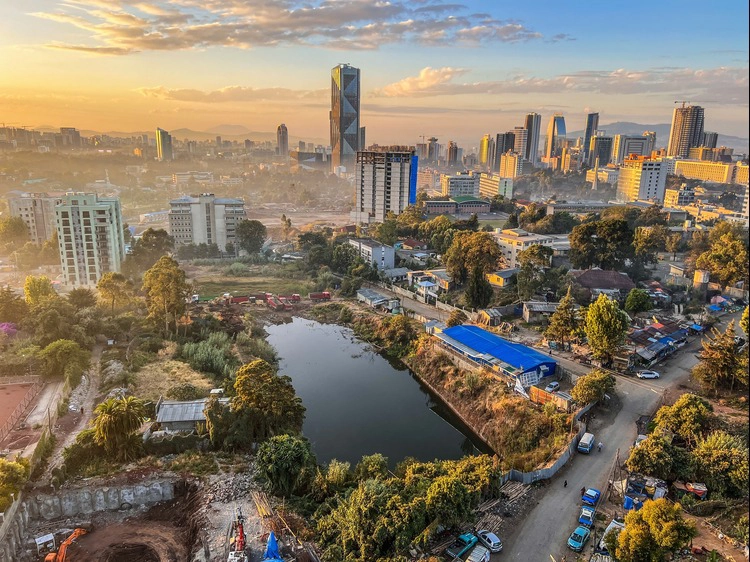
Discover the top five countries that consider climate change a looming threat, and the five countries least concerned across the world
By
Against the backdrop of COP29 in Baku, climate change rears its head as an undeniable and ever-growing threat. As 2024 is expected to be the warmest year on record, trillions of dollars – along with huge global efforts to forge policies and stick to them – are required if countries are to reduce their greenhouse gas emissions and lessen the extent to which climate change impacts our planet.
But where exactly are people feeling the threat of climate change the most? And conversely, what parts of the world do people consider climate change a lesser priority?
In the recent World Risk Survey conducted this year, 147,000 participants across 142 nation were asked the same question: ‘will climate change be a threat to your country in the next 20 years?’
Enjoying this article? Check out our other climate reads:
From country to country, answers varied.
The percentage below refers to the number surveyed in each nation who believe climate change will pose some form of threat to their country in the next twenty years.
Here we cover the top five countries most and least concerned about climate change – according to the 2024 World Risk Survey – along with details of these countries’ climate efforts and what exactly the impacts of climate change will have on them.
Countries with respondents most concerned by climate change
5) South Korea – 94 per cent

94 per cent of respondents in South Korea said that climate change would pose a threat to their country in the next 20 years.
Although its citizens are concerned by the risks of a warming planet, the overall policies and action in place in South Korea to reduce the effects of climate change are ranked as highly insufficient by the Climate Action Agency. Between 1990 and 2020, greenhouse gas emissions in the country more than doubled, largely due to its prominent steel industry that contributes 40 per cent of the total emissions.
If all countries were to follow the same level of ambition as South Korea’s 2030 plan – which are not consistent with the Paris Agreement’s 1.5°C temperature limit – global warming could exceed 3C and reach up 4C.
In recent years, the country has advanced its enforcement of a net zero target, although this lacks clarity on emissions and specific details in the reviewing process.
With the Democratic Party winning in South Korean elections this year, pledges have been made to create more ambitious environmental policies – including phasing out coal-fired power plants by 2040, and boosting renewable energy production to 40 per cent by 2035 – that may turn the tide on the country’s climate action.
4) Georgia – 94 per cent

Despite Georgia contributing just 0.03 per cent of the total greenhouse gas emissions globally, the country is considered highly vulnerable to the effects of climate change, and 94 per cent of respondents in the country felt that climate change would threaten the country in the next 20 years too.
Since 1958, the amount of precipitation falling during heavy rainstorms has increased by 27 per cent in the southeast of Georgia. Particularly, sea levels rise more rapidly in Georgia than along other coasts because the land is sinking.
To combat the impact of climate change, Georgia took on a commitment to reduce greenhouse gas emissions by 50-57 per cent by 2030 compared to its 1990 levels.
3) Austria – 94 per cent

Climate-conscious Austria ranks number three in the World Risk Survey.
The country is particularly vulnerable to climate change thanks to both its mountainous terrain and the high number of rivers and streams. With more than 25,000 bodies of water, and more than 23,000 named summits, Austria is vulnerable to long-lasting and extensive flooding affecting both flat and hilly regions.
In particular, the Salzburg state is one of the country’s flooding hotspots – but also home to six per cent of the Austrian population, and 7.5 per cent of the country’s GDP. Therefore, protecting the planet is also in the interest of preserving Austria’s economic foothold.
Austria has been making steps in the right direction to reduce its greenhouse gas emissions, which were seven per cent lower in 2021 than its 1990 levels.
Amongst other measures, it has enacted a governmental policy to set emission ceilings for six key sectors in the country – energy and industry, transport, buildings, agriculture, waste management and fluorinated gases.
2) Germany – 95 per cent

Since 1990, emissions in Germany have fallen by 46.1 per cent. Its greenhouse gas emissions fluctuate depending on both its economy and the geopolitical climate and world events. For example, its emissions declined by nine per cent in 2020 due to the COVID-19 pandemic and then dropped by ten per cent in 2023 as a result of the energy crisis exacerbated by the Russia-Ukraine war.
To curb its greenhouse gas emissions, Germany plans to phase out coal-fired power generation by 2038.
It also brought out its first national climate law back in 2019, which now contains annual emission budgets – equivalent to those of the wider European greenhouse gas emission reduction plans – for individual sectors, like industry and transport, until 2030. However, the latest amendment of the law made these budgets no longer binding, weakening the responsibility of industries.
Climate change has a clear impact on the nation, with projections suggesting rivers such as the Rhine – which depend on glacial melt – becoming much smaller if glaciers do disappear by the end of the century. Sea level rise could also lead to flooding along Germany’s North Sea and Baltic Sea coasts, causing an estimated loss of €7.6 billion each year by the 2080s if adaptations are not appropriately made.
1) Spain – 96 per cent

The country with the most climate-conscious respondents in the recent world risk survey was Spain, where 96 per cent of those surveyed believe climate change will pose a threat to them in the next 20 years.
Recent flooding in Spain has highlighted just how devastating the impacts of climate change can be on the country. At least 150 people died in eastern Spain due to flash floods in October, with homes and entire communities devastated. So significant and unprecedented was the rainfall that by the time emergency services were able to alert the public of the weather, many were already outside or working in low-level areas that posed a major threat to life.
Scientists have pointed to two reasons that caused these floods, both linked to human-induced climate change – changes in the jet stream, or warmer air holding – and then releasing – more rain.
Countries with respondents least concerned by climate change
5) Libya – 42 per cent

One of the world’s driest countries – with less than two per cent of its land receiving enough rain for agricultural purposes – Libya faces real threats from worsening climate change, despite ranking at number five in the survey.
One such example is Storm Daniel – the deadliest storm to hit Africa for more than a century – which brought 70-80mph winds to the country along with torrential rainfall, killing 5,600 people and displacing 45,000. Rising sea levels, shoreline erosion and worsening drought conditions also affect the country.
With the largest proven oil reserves in Africa, Libya relies heavily on oil exports for a source of income, leading it to also have the highest-per-capita carbon emission rate in Africa. To help the country shift away from these planet-polluting resources, funding has been provided this year by the European Union to support its transition to renewable energy, as well as improve energy efficiency and mitigate the effects of climate change.
Due to high temperatures and the lack of a comprehensive water plan, Libya is also one of the most water-stressed nations across the world. With climate change bringing about higher temperatures and less rainfall, even more pressure is placed on these water resources, increasing the likelihood of water scarcity.
4) Ethiopia – 39 per cent

Almost two in five Ethiopians believe climate change poses no threat to them at all. This is despite evidence which suggests the country is at risk from the impacts of climate change right now.
Climate change projections suggest that the average annual temperature in Ethiopia could rise from 20C to as high as 24C – with 71 days a year above 35C. Severe flooding – which the country experience in 2023 – could also increase due to climate change, as very dry and cracked ground cannot absorb high volumes of rainwater.
If climate change continues on the same trajectory, a World Bank report revealed that Ethiopia would lose at least 1–1.5 per cent of its GDP – and potentially up to 5 per cent by the 2040s – leading to many millions of Ethiopians being put into poverty.
3) Myanmar – 39 per cent

Climate change brings about increased extreme weather events, including storms and floods – both of which are key drivers of poverty in Myanmar. Despite this, just 39 per cent of respondents in Myanmar said climate change posed a threat to their country in the next 20 years.
The country’s highly exposure to tropical cyclones – the most recent being Cyclone Mocha in May 2023 – makes it vulnerable to climate change too. Between 2000–2019, Myanmar ranked as the second-most affected country by climate change losses, including the devastating impact of Cyclone Nargis back in 2008 that killed almost 140,000 people.
40 per cent of its inhabitants live in low-lying or coastal regions, further exacerbating the effects of heavy rainfall and floods that may arise due to the warming planet.
Prior to the conflicts in the country in recent years, the Myanmar government began to make real headway in climate action, publishing its own national strategy back in 2019. Yet now, as displacement of civilians occurs along with environmental degradation – as well as the heightened security risks that environmental activists and local civil society organisations face – the scope to make clear and tangible changes in climate policies is becoming narrower.
2) Laos – 37 per cent

Although not a major contributor of greenhouse gases, Laos is likely to be disproportionately affected by the impacts of climate change, particularly in its agricultural sector. Around 70 per cent of the population rely on this sector for their livelihoods, but climate change brings about unprecedented weather patterns which make earning a stable and guaranteed income from traditional agricultural systems more and more challenging.
Despite ranking low in the recent survey, the effects of climate change on the country are stark. Projections suggest Laos may experience more extreme weather, a 2-3C rise in temperature by 2050 and a 10–30 per cent increase in rainfall if the planet continues on the same climate trajectory.
Targets have been set in Laos to mitigate the effects of climate change, such as those aiming for the country to have 30 per cent electric vehicles by 2030 as well as goals to diversify its energy sources to more non-hydro renewable energy.
1) Saudi Arabia – 28 per cent

At number one is Saudi Arabia, where just 28 per cent of respondents believe climate change poses a threat to their country in the next 20 years.
The world’s leading crude oil exporter, Saudi Arabia is a major player on the oil and gas scene and even plans to increase its oil output over the next few years, with its national oil company Aramco.
According to Climate Action Tracker, the policies and climate-related action of Saudi Arabia are ranked as ‘critically insufficient’, with the country announcing a 2060 net zero target back in 2021 that has since not been expanded upon or placed into law. Clear emission reduction pathways to net zero have also not been made by Saudi Arabia.




